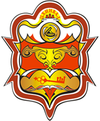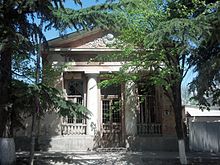Tskhinvali
|
Tskhinvali ცხინვალი хинвал |
||
|
||
| State : |
|
|
| Region : |
Inner Kartlien (in fact South Ossetia ) |
|
| Founded : | 1398 | |
| Coordinates : | 42 ° 14 ' N , 43 ° 58' E | |
| Height : | 860 m. ü. M. | |
| Area : | 7.4 km² | |
| Residents : | 28,664 (2012, approximate value) | |
| Population density : | 3,874 inhabitants per km² | |
| Time zone : | De jure: Tbilisi time ( UTC + 4 ), de facto: Moscow time ( UTC + 3 ) | |
| Mayor : | Alan Alborow | |
| Website : | ||
|
|
||
Tskhinvali ( Georgian ცხინვალი ; Ossetian and Russian Цхинвал / Tskhinval , until 2008 Цхинвали / Tskhinvali ) is a city in the Tskhinvali region. It is the capital of the controversial Republic of South Ossetia , recognized internationally only by a few states , which belongs to Georgia under international law and is regarded there as part of the Inner Kartlien region . Tskhinvali is located in the Greater Caucasus on the banks of the Great Liachwi .
Surname
Tskhinvali is the name officially used in Georgia for the region of South Ossetia. The Georgian name translates as "The land of the hornbeams ". In Ossetian and Russian, and thus also in South Ossetia itself, the name Tskhinval is used. The unofficial Ossetian name is Tschreba .
In Russian usage during the Soviet era, both forms of the name, Tskhinvali and Tskhinval, were used, but since the Caucasus War in 2008 , only the term "Tskhinval" has been used following a presidential decree. From 1934 to 1961 the city was called Staliniri in honor of Stalin .
Economy and Transport

In 1940 Tskhinvali was connected to the Georgian railway network. It is a regional industrial center with sawmills, food, textile and chemical plants.
In front of the city, in the village of Ergneti, there was a large black market for smuggled goods from Russia, which was mainly visited by traders from northern Georgia. It was closed by the Georgian authorities in the summer of 2004. Since 2008, the whole of South Ossetia has been under the control of the Republic of South Ossetia, which is recognized by only a few states, and Russia has since invested heavily in the reconstruction of the region.
population
The majority of the population of Tskhinvali consists of Ossetians today, with smaller Georgian , Russian and Armenian minorities living in the city. Compared to 1989, the number of inhabitants fell sharply due to the South Ossetia conflict and the political situation that is still uncertain today. In particular, most of the non-Ossetian population has since left the city. A slight upward trend has been observed since 2008.
Until the beginning of the 20th century, Tskhinvali was predominantly inhabited by Georgian Jews , Georgians and Armenians, while Ossetians were only a small minority of residents. Georgians also made up the majority in the immediate vicinity of the city. In the entire administrative district ( Tskhinvalsky utschastok des Ujesds Gori of the Tbilisi Governorate ), however, the Ossetians were clearly in the majority. In 1917, 38.4 percent Jews, 34.4 percent Georgians, 17.7 percent Armenians and 8.8 percent Ossetians lived in Tskhinvali.
After it became the administrative center of the South Ossetian Autonomous Region , more and more Ossetians moved to the city from the surrounding area.
In 1979 the city's population consisted of 72.8 percent Ossetians, 16.1 percent Georgians, 5 percent Russians, 2 percent Armenians and 1.9 percent Jews. By the last official census in 1989, the population rose to 42,333, of which 74.5 percent were Ossetians and 16.3 percent Georgians. Demographic conditions had also changed in the outskirts of the city, here the Georgian population, which was 32.7 percent in 1939, increased, so that in 1989 there were 52.6 percent Ossetians compared to around 46.5 percent Georgians. The majority of Georgians have left the country since the South Ossetia conflict. An informal pro-house survey (подворовой опрос) identified around 28,662 residents in 2012. The next census was planned for 2015.
| year | 1959 | 1970 | 1979 | 1989 | 2005 | 2008 | 2012 | 2015 |
| Residents | 21,641 | 30,311 | 34,791 | 42,333 | 33,724 | 15,000 | 28,662 | 30,432 |
Note : 1926–1989 census data, 2005, 2015 surveys, 2008 estimated
history
The area around Tskhinvali has been populated since the Bronze Age. Today's Tskhinvali was first mentioned in Georgian sources in 1398. In 1801 the city, like other parts of Georgia, fell to the Russian Empire . It was conveniently located on a trade route between the North Caucasus and Tbilisi and developed over time into a regionally important trade hub with a mixed population of Georgians, Jews, Ossetians and Armenians. After the Russian October Revolution in 1917, the city became part of the newly established Democratic Republic of Georgia . From 1918 to 1920, the city was then shaped by the Georgian-South Ossetian conflict . In 1921 the Soviet Union finally occupied all of Georgia. Tskhinvali was then appointed the administrative center and capital of the South Ossetian Autonomous Region and got city status .
To the southwest of the city of Tskhinvali is an extensive military installation, which dates back to the Soviet era and originally consisted of more than 60 silos for nuclear ICBMs . This is also the reason for the comparatively high Russian population in the region.
In 1990 Georgia was one of the first republics to break away from the collapsing Soviet Union. In the South Ossetian area, however, the majority supported remaining with the Soviet Union. In 1990 Georgia broke away as an independent Soviet republic, whereupon Georgian troops tried to recapture the area. In the subsequent South Ossetian conflict from 1990 to 1992 Tskhinvali was badly damaged. War crimes occurred and houses were set on fire. Tskhinvali was temporarily split into an Ossetian-controlled western part and a Georgian-controlled eastern part. After a ceasefire brokered by Russia, Tskhinvali became the seat of the Joint Control Commission of the Georgian-Ossetian-Russian peacekeeping force under the supervision of the OSCE in 1994 .
During the Caucasus War in 2008, the Georgian army attacked Tskhinvali on August 8 and occupied parts of the city. Large parts of Tskhinvali were destroyed and civilian targets were attacked. Russian associations then intervened in the conflict. The Georgian troops therefore withdrew from the city on August 9th.
An analysis by the United Nations , based on aerial photographs after the end of the fighting , found that parts of the old town near the Great Liachwi and administrative buildings had been completely destroyed. The number of badly damaged and destroyed buildings in the fighting on August 8, 2008 in the city was therefore around 250. Moscow's mayor Yuri Luzhkov announced in October 2008 that Russia's capital would invest over 100 million US dollars in new residential buildings, Build schools and shopping centers. Since 2009, the funds from the Russian capital have been used to create a new district of Moskovsky , in which spacious apartments are being built for around 800 Ossetian families who have remained without a home.
Town twinning
-

 Tiraspol , Transnistria in the Republic of Moldova
Tiraspol , Transnistria in the Republic of Moldova
-
 Saratov , Russia
Saratov , Russia -

 Sukhumi , Abkhazia in Georgia
Sukhumi , Abkhazia in Georgia
sons and daughters of the town
- Josif Kricheli (1931–1988), grand master of chess composition
- Ludwig Tschibirow (* 1932), South Ossetian historian and politician
- Merab Eliosishvili (1934–2012), Georgian writer
- Alimbek Bestajew (1936–1988), Soviet wrestler
- Guram Zchowrebow (1938–1998), Soviet football player
- Alla Dschiojewa (* 1949), South Ossetian politician
- Eduard Kokoity (* 1964), President of South Ossetia
- Sinaida Bestajewa (* 1967), former Minister of State of Georgia
- Akakios Kachiasvilis (* 1969), Olympic and world champion in weightlifting
- Dmitri Sanakojew (* 1969), South Ossetian politician
- Vadim Bogiev (* 1970), Russian wrestler
- Irakli Okruashvili (* 1973), former Defense Minister of Georgia
- Vadim Gaglojew (* 1989), Russian football player
Individual evidence
- ↑ Михаил Николаевич Тихомиров - Академия наук СССР, археографическая комиссия Археографический ежеже. - М .: издательство Академии наук СССР, 1962, p. 417. (Russian).
- ↑ a b Population data by ethnic group (Russian).
- ↑ Цхинвали. (Russian).
- ↑ РЕСПУБЛИКА ЮЖНАЯ ОСЕТИЯ ( Memento from April 28, 2015 in the Internet Archive ) (Russian).
- ↑ 42 ° 11 '24.1 " N , 43 ° 55' 58.4" E
- ↑ Georgia News: South Ossetia: Georgian forces storm Tskhinvali. Article dated August 8, 2008
- ↑ Tagesschau : Russia apparently bombs targets in Georgia ( Memento from August 14, 2008 in the Internet Archive ) from August 9, 2008.
- ↑ Georgia is relocating its troops. Spiegel Online from August 10, 2008
- ↑ The Guardian: I've never heard anything so monstrous as people shelling a hospital. Article dated August 13, 2008.
- ↑ Archive link ( Memento of the original from August 28, 2008 in the Internet Archive ) Info: The archive link was inserted automatically and has not yet been checked. Please check the original and archive link according to the instructions and then remove this notice.
- ↑ Focus Information Agency: "International Herald Tribune": Mayor of Moscow speaks out for Russians in former Soviet republics. October 27, 2008 (English).
- ↑ The Independent: Ossetians hot to Moscow's embrace. August 9, 2009 (English).





